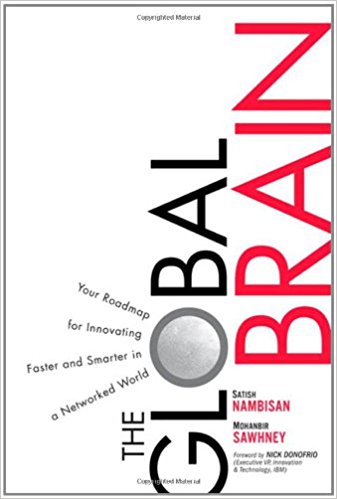The Global Brain Summary
4 min read ⌚
 Your Roadmap for Innovating Faster and Smarter in a Networked World
Your Roadmap for Innovating Faster and Smarter in a Networked World
Contemporary companies must be open to the world and tap into talent, ideas, and technology from all around the planet. That is the only way the will be able to stay competitive on the market.
Who Should Read “The Global Brain”? and Why?
The notion of “The Global Brain” has been around for some time now.
However, as the years pass, and as India’s and China’s economies continue to strengthen, and their employees’ technical expertise expands, the concept is gaining importance in the business world.
Satish Nambisan and Mohanbir Sawhney have written “The Global Brain” for that reason. In it, they give you enough reasons that you should consider using “network-centric innovation” (NCI) in your firm.
We recommend this book to research and development experts, executives, and managers who want to stay up to date and create the environment to innovate.
About Satish Nabisan and Mohanbir Sawhney
Satish Nambisan is an author and an associate professor at the Rensselaer Polytechnic Institute’s Lally School of Management.
 Mohanbir Sawhney is the director of the Center for Research in Technology & Innovation at Northwestern University.
Mohanbir Sawhney is the director of the Center for Research in Technology & Innovation at Northwestern University.
“The Global Brain Summary”
New items that companies offer to their clients enable them to survive in the marketplace.
This has never been truer than it is today.
During the past few decades, life cycles of goods have been shortening. Once upon a time, products could be sold for years without significant modifications. Now, they become outdated in only months.
So what can you do to “beat” the market?
Well, you need to innovate more. And to do so, you have to reduce the cost that comes with innovation.
Companies no longer have the resources to buy technical infrastructure and build big in-house teams for product development. At the same time, the race for innovation is quickening and running as fast as you can only keep you in place. To move, you have to run even faster than you can.
However, isn’t that impossible?
No, it is not. You can make it happen by building innovation networks with other companies.
Nowadays companies are creating global resource networks that allow them to combine their different expertise. The aggregate of organizations, experts, and technologies involved in the process make the “Global Brain.” Your firm can use the “Global Brain” anytime it needs to push for innovation and results.
Networking enables you to give the market the right products that are in demand, at a cost which is lower than the individual cost that your firm would have if you did not use the “Global Brain.” Furthermore, it allows you to share technology, extend the geographic reach of your business, use infrastructure efficiently and ask for help from outside experts.
The set of factors that support and fuel the “Global Brain” consists of the Internet, globalized manufacturing, open source software, outsourcing and private labeling.
Key Lessons from “The Global Brain”
1. Understanding Network-Centric Innovation
2. Methods of Network-Centric Innovation
3. Making it happen
Understanding Network-Centric Innovation
There are two sides to network-centric innovation: the nature of the innovation and the nature of the network leadership.
To define the first one determine where your product or service is on a continuum from “emergent” to “defined.”
The leadership can be “diffused,” “centralized,” or somewhere in between. What are the differences? In a diffused network, all participants have leadership responsibilities. Centralized systems, on the other hand, have a core, that makes the decisions, and a periphery that complies with them.
Methods of Network-Centric Innovation
The intersection of the nature of innovation and network leadership creates four models of network-centric innovation.
-
- The Orchestra model (best for defined innovation and centralized network)
-
- The Creative Bazaar model (best for emergent innovation and centralized network)
-
- The Jam Central model (best for emergent innovation and diffused network)
- The MOD Station model (best for defined innovation and diffused network)
Making It Happen
After you realize which network-centric model suits you best, start thinking about the changes you need to implement in your organization for it to be able to innovate more successfully.
Start by creating an inventory of the resources and capabilities you currently have at hand and write down a plan to strengthen the weak areas. Before continuing to implementation, make sure you have all the tools necessary to support innovation initiatives.
It would not hurt if you learned about other companies’ best practices in the field of innovation and tried to use the ones that suit you in your own business.
Don’t forget your corporate culture. You have to change it so it can support the changes you are about to make. Especially be careful if your company has the “we know everything” syndrome, which is undoubtedly going to stop you from brainstorming new ideas. Lastly, you will most likely have to make structural changes as well.
Like this summary? We’d Like to invite you to download our free 12 min app, for more amazing summaries and audiobooks.
“The Global Brain” Quotes
Rapidly decreasing product life cycles, decreasing internal innovation productivity and global competition are creating a Red Queen effect in innovation: Companies have to invest more and more just to maintain their market position. Share on X An innovation network consists of a set of independent actors with varying goals and aspirations, diverse resources and capabilities, and different business models. Share on X Governance is more than just policing. It also involves creating an environment that is conducive to interacting and exchanging information and resources. Share on X Despite the community-based innovation agenda and governance system of the Jam Central model, abundant opportunities exist for large for-profit companies to participate in such initiatives. Share on X Firms don’t play the role of an innovation sponsor as an act of altruism or social service. Such decisions are always based on a sound business case. Share on XOur Critical Review
The authors tried to make their book “The Global Brain” practical, but when you are in the position of a reader, you will find it quite theoretical. It is filled with anecdotes and metaphors, but even though the explanations of the models are clear, it will be up to you to find a way to turn them into practice.
Emir is the Head of Marketing at 12min. In his spare time, he loves to meditate and play soccer.


 Your Roadmap for Innovating Faster and Smarter in a Networked World
Your Roadmap for Innovating Faster and Smarter in a Networked World




